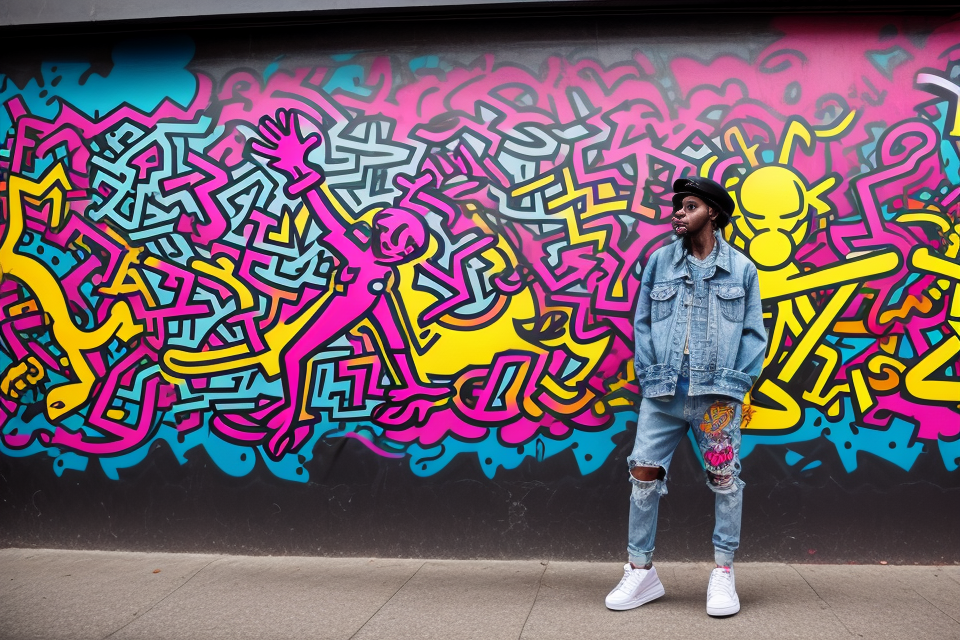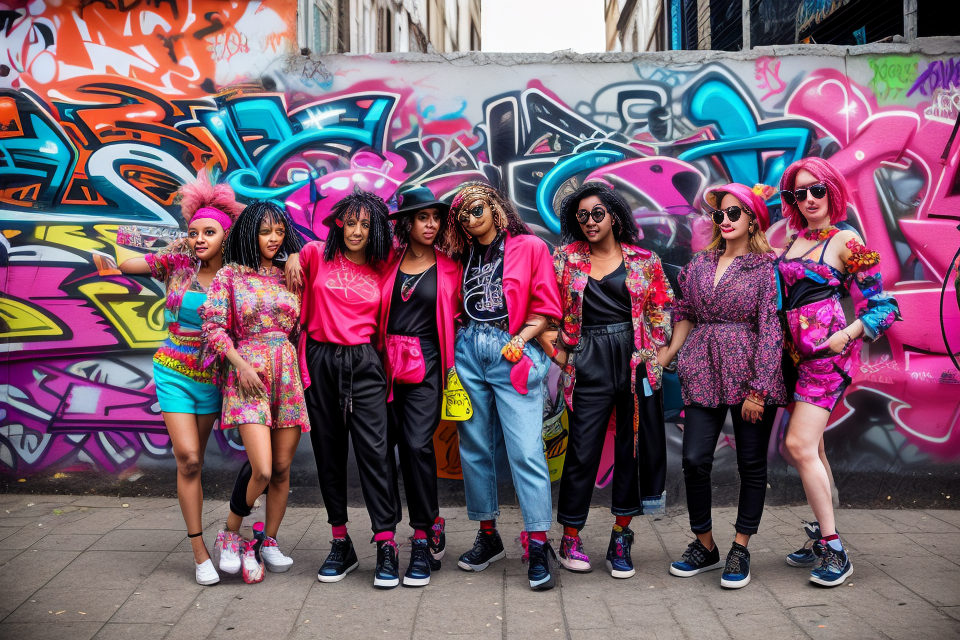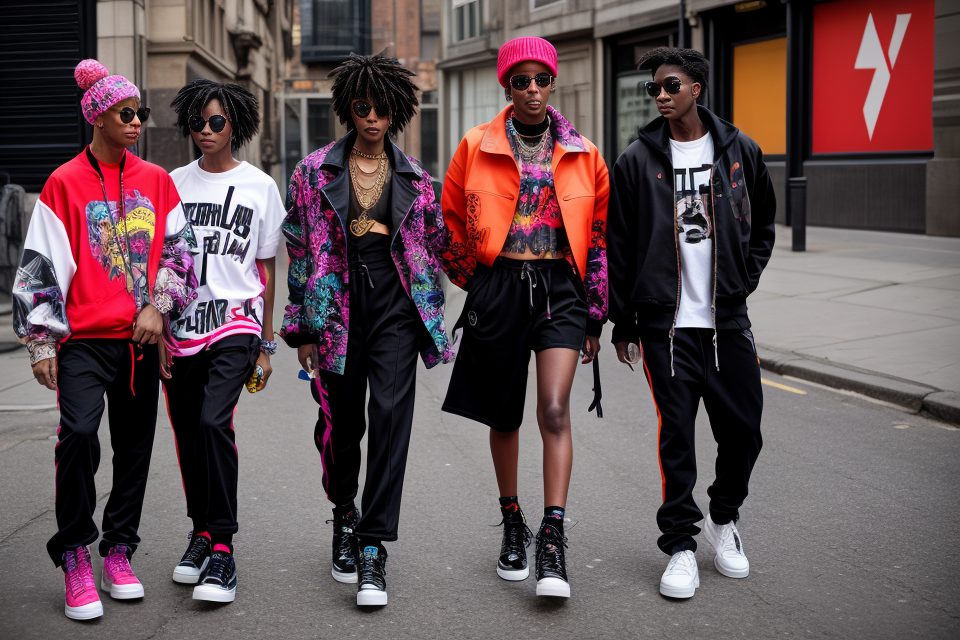
Street fashion is a dynamic style movement that has been evolving for decades. It’s a style that is often associated with youth culture and is characterized by its edgy, urban feel. Street fashion is all about self-expression and individuality, and it’s often influenced by popular culture, music, and art. From the early days of punk and grunge to the current trends of streetwear and athleisure, street fashion has come a long way. In this article, we’ll take a comprehensive look at the evolution of street fashion and explore some of the key trends and influences that have shaped this unique style movement.
The Origins of Street Fashion: From Rebellion to Runways
The Emergence of Streetwear in Urban Culture
- Early influences from hip-hop, skateboarding, and punk rock
- Rise of brands like Stussy, Nike, and Adidas
- Streetwear as a reflection of urban youth culture
The emergence of streetwear in urban culture can be traced back to the early 1980s, where it began as a form of rebellion against mainstream fashion. It was heavily influenced by the cultures of hip-hop, skateboarding, and punk rock, which all played a significant role in shaping the aesthetics of streetwear.
Skateboarding culture, in particular, had a significant impact on the emergence of streetwear. Skaters often customized their clothing, adding their own logos and designs to create a unique look. This DIY approach to fashion became a defining characteristic of streetwear, with many brands adopting this philosophy and incorporating it into their designs.
Another significant influence on the emergence of streetwear was hip-hop culture. Hip-hop artists began to incorporate fashion into their music videos and live performances, showcasing a range of urban styles and trends. Brands like Stussy, which was founded by a surfer named Shawn Stussy, began to capitalize on this trend by creating clothing that reflected the hip-hop aesthetic.
Punk rock culture also played a role in the emergence of streetwear. Punk rockers rejected mainstream fashion and instead embraced a DIY approach to clothing, often wearing torn and customized clothing. This attitude towards fashion was reflected in the early streetwear brands, which often incorporated elements of punk rock into their designs.
The rise of brands like Nike, Adidas, and Stussy also played a significant role in the emergence of streetwear. These brands began to produce clothing and footwear that reflected the aesthetics of urban youth culture, incorporating elements of hip-hop, skateboarding, and punk rock into their designs. This helped to further legitimize streetwear as a distinct style movement, and it paved the way for the continued evolution of street fashion.
In conclusion, the emergence of streetwear in urban culture was heavily influenced by the cultures of hip-hop, skateboarding, and punk rock. These influences helped to shape the aesthetics of streetwear, and they laid the foundation for the continued evolution of street fashion.
The Transition to High-Fashion
- The influence of designers like Margiela and Galliano
- Maison Margiela’s experimental approach to fashion
- Repurposing and deconstructing garments
- Examining the intersection of high-fashion and streetwear
- John Galliano’s theatrical and daring designs
- Incorporating elements of street fashion into haute couture
- Merging the boundaries between traditional fashion and streetwear
- Maison Margiela’s experimental approach to fashion
- Streetwear collaborations with luxury brands
- The rise of luxury streetwear collaborations
- Brands like Supreme and Louis Vuitton
- Exploring the fusion of high-fashion and streetwear
- The impact of these collaborations on the fashion industry
- Attracting new customers to luxury brands
- Expanding the reach of streetwear culture
- The rise of luxury streetwear collaborations
- The democratization of fashion through social media
- The role of social media in the fashion industry
- Providing a platform for emerging designers
- Empowering individuals to express their personal style
- The impact of social media on street fashion
- The rise of influencers and fashion bloggers
- Street fashion trends going viral
- The role of social media in the fashion industry
Breaking Down the Elements of Street Fashion
The Staples of Street Style
Oversized Silhouettes
Oversized silhouettes have been a staple of street fashion for decades. From oversized denim jackets to baggy jeans, this trend has been consistently popular among those looking to make a statement with their style. The appeal of oversized silhouettes lies in their ability to create a relaxed, laid-back look that is both comfortable and fashionable. Whether paired with a crop top or a t-shirt, oversized silhouettes have become a wardrobe essential for many.
Graphic Tees and Slogans
Graphic tees and slogans have been a mainstay of street fashion for years. These tops often feature bold designs and eye-catching slogans that make a statement and help individuals express their personal style. From politically charged slogans to humorous graphics, graphic tees and slogans offer a way for individuals to express themselves through their clothing. They can be dressed up or down, making them a versatile addition to any wardrobe.
Sportswear and Athleisure
Sportswear and athleisure have become a dominant force in street fashion in recent years. This trend has been driven by the rise of activewear brands and the growing popularity of sports-inspired styles. From joggers and hoodies to sneakers and athletic vests, sportswear and athleisure have become a staple of street fashion. The appeal of this trend lies in its ability to blend comfort and style, creating a look that is both functional and fashionable.
Statement Sneakers
Statement sneakers have become a key element of street fashion in recent years. These sneakers often feature bold designs and eye-catching colors that make a statement and help individuals express their personal style. From high-tops to low-tops, statement sneakers come in a variety of styles and can be dressed up or down to suit any occasion. Whether paired with denim or a suit, statement sneakers have become a wardrobe essential for many.
Accessorizing with Hats, Backpacks, and Sunglasses
Accessorizing with hats, backpacks, and sunglasses has become a staple of street fashion. These accessories offer a way for individuals to express their personal style and add a touch of personality to their look. From baseball caps to bucket hats, hats have become a popular accessory among those looking to make a statement with their style. Backpacks have also become a wardrobe essential, offering both function and fashion. And sunglasses, with their ability to shield the eyes from the sun and add a touch of glamour to any look, have become a must-have accessory for many.
The Evolution of Street Fashion Icons
- The Influence of Cultural Icons
- Kanye West: A Pioneer of Street Fashion
- His early career and fashion sense
- The impact of his collaborations with high-end fashion brands
- The launch of his own fashion line, Yeezy
- A$AP Rocky: The Streetwear Trailblazer
- His personal style and its influence on fashion
- The success of his collaboration with Guess and other fashion brands
- The launch of his own fashion label, SVRGN
- Kanye West: A Pioneer of Street Fashion
- The Emergence of Streetwear Influencers on Social Media
- The rise of Instagram and YouTube as platforms for fashion influencers
- The impact of streetwear influencers on consumer trends
- Examples of successful streetwear influencers and their influence on the fashion industry
- The Intersection of Street Fashion with Haute Couture
- The history of streetwear and high fashion collaborations
- The role of luxury fashion brands in the streetwear movement
- Examples of successful collaborations between streetwear and haute couture, such as Virgil Abloh’s work with Louis Vuitton and Off-White.
Street Fashion Today: Global Trends and Cultural Significance
The Global Reach of Street Fashion
The Impact of Globalization on Streetwear
In recent years, globalization has played a significant role in the proliferation of streetwear fashion. The rise of social media platforms, e-commerce, and the ease of international travel have enabled streetwear to reach a global audience. This has led to a more diverse and eclectic mix of styles, as well as an increased interest in streetwear fashion from different cultures around the world.
The Rise of Regional Streetwear Scenes
As streetwear has gained popularity worldwide, regional streetwear scenes have emerged, each with its unique style and influence. For example, in Japan, streetwear has been a prominent subculture since the 1990s, with brands like A Bathing Ape (BAPE) and Comme des Garçons leading the way. Similarly, in the United States, brands like Supreme and Stussy have become iconic streetwear labels. These regional scenes have helped to shape the global streetwear landscape and have inspired designers and brands in other countries to create their own unique streetwear styles.
The Role of Street Fashion in Bridging Cultural Gaps
Streetwear has also played a significant role in bridging cultural gaps and promoting cultural exchange. As streetwear has become more popular worldwide, it has brought together people from different cultures and backgrounds. This has helped to break down barriers and promote understanding and appreciation of different cultures. Streetwear has also provided a platform for artists, designers, and brands from different cultures to showcase their work and connect with a global audience.
The Cultural Significance of Street Fashion
Street fashion has evolved from being a mere style movement to a cultural phenomenon that carries deep-rooted meaning and significance. Its cultural significance can be observed in several aspects, including self-expression, politics, and influence on high-fashion designers.
Street fashion as a form of self-expression
Street fashion has become a platform for individuals to express their unique style and personalities. It allows people to break free from traditional fashion norms and embrace their individuality. Streetwear, in particular, has become a popular subculture that celebrates the DIY (do-it-yourself) ethos, encouraging people to customize and personalize their clothing. This has led to the rise of streetwear brands that focus on limited edition and exclusive collaborations, making streetwear a highly sought-after and exclusive form of self-expression.
The politics of streetwear and the critique of mainstream fashion
Street fashion has also become a platform for political and social commentary. Streetwear, in particular, has been used as a tool to critique mainstream fashion and its societal expectations. Brands like Supreme and Off-White have been known to incorporate political and social messages into their designs, reflecting the voices of marginalized communities and sparking important conversations around issues such as race, gender, and class. This has given streetwear a political edge, making it a powerful tool for social change.
The influence of street fashion on high-fashion designers
Finally, street fashion has had a significant impact on high-fashion designers, who have been influenced by the unique styles and trends of the streetwear culture. Streetwear brands have collaborated with high-fashion designers, blurring the lines between high and low fashion. This has led to the incorporation of streetwear elements into high-fashion collections, such as oversized silhouettes, sportswear influences, and bold graphic prints. This fusion of streetwear and high fashion has created a new aesthetic that has come to define the current state of fashion.
In conclusion, street fashion has evolved into a cultural phenomenon that carries deep-rooted meaning and significance. Its cultural significance can be observed in self-expression, politics, and influence on high-fashion designers. As streetwear continues to gain popularity and influence, it will be interesting to see how it continues to evolve and shape the fashion industry.
The Future of Street Fashion: Predictions and Possibilities
The Continued Evolution of Streetwear
The Impact of Sustainability and Ethical Fashion
As the fashion industry becomes increasingly aware of its environmental impact, streetwear brands are following suit. The future of streetwear is likely to involve a greater focus on sustainability and ethical practices. This includes using eco-friendly materials, reducing waste, and ensuring fair labor practices throughout the supply chain. As consumers become more conscious of the environmental impact of their purchases, brands that prioritize sustainability will be in high demand.
The Rise of Digital Fashion and the Metaverse
Another trend that is likely to shape the future of streetwear is the rise of digital fashion and the metaverse. The metaverse is a virtual world where users can interact with each other and digital objects. This new frontier offers a unique opportunity for streetwear brands to showcase their designs in a virtual environment. Digital fashion is also expected to play a significant role in the future of streetwear. Brands can use digital tools to create unique designs and even offer virtual try-on experiences for customers.
The Potential for New Streetwear Subcultures
As streetwear continues to evolve, there is potential for the emergence of new subcultures. These subcultures will be shaped by factors such as geography, music, and social media. For example, a new streetwear scene may emerge in a city with a thriving music scene, or a new subculture may be created around a particular social media platform. As streetwear continues to diversify, these new subcultures will play a significant role in shaping the future of the movement.
In conclusion, the future of streetwear is bright, with many possibilities for growth and evolution. As the movement continues to evolve, it will be shaped by factors such as sustainability, digital fashion, and new subcultures. Brands that are able to adapt to these changes and stay ahead of the curve will be well-positioned for success in the years to come.
The Enduring Appeal of Street Fashion
The popularity of street fashion has remained steadfast over the years, with many people continuing to be drawn to its unique style and aesthetic. There are several reasons why street fashion remains an enduring appeal, including:
- The versatility and accessibility of streetwear: One of the key reasons why street fashion is so appealing is that it is both versatile and accessible. Streetwear clothing is often designed to be worn in a variety of different settings, from casual everyday wear to more formal occasions. Additionally, streetwear is often more affordable than high-end fashion, making it accessible to a wider range of people.
- The continued influence of street fashion on mainstream fashion: Street fashion has had a significant impact on mainstream fashion over the years, with many high-end designers incorporating streetwear-inspired elements into their collections. This continued influence has helped to keep street fashion relevant and has ensured that it remains an important part of the fashion industry.
- The role of streetwear in shaping the future of fashion: Streetwear has played a significant role in shaping the future of fashion, particularly in terms of the way that people think about and approach fashion. By challenging traditional fashion norms and encouraging people to think outside the box, streetwear has helped to pave the way for new and innovative fashion trends.
Overall, the enduring appeal of street fashion is due to its versatility, accessibility, and continued influence on mainstream fashion. As the fashion industry continues to evolve, it is likely that streetwear will continue to play an important role in shaping the future of fashion.
FAQs
1. What is street fashion?
Street fashion is a style of dress that originated in the streets and is characterized by its edgy, urban, and often rebellious look. It is often associated with youth culture and is known for its trendy, often eclectic, mix of clothing and accessories.
2. What are some examples of street fashion?
There are many different examples of street fashion, and it can vary widely depending on the cultural and geographic context. Some common elements of street fashion include oversized clothing, distressed or ripped denim, bold graphic tees, statement sneakers, and accessories such as hats, backpacks, and chains.
3. How has street fashion evolved over time?
Street fashion has evolved significantly over the past few decades, influenced by changing cultural trends and the rise of social media. In the 1980s and 1990s, street fashion was heavily influenced by hip hop and punk subcultures, with brands like Nike and Tommy Hilfiger becoming popular among young people. In the 2000s and 2010s, street fashion became more mainstream, with luxury brands such as Gucci and Supreme adopting streetwear-inspired styles. Today, street fashion continues to evolve and is often influenced by trends in music, art, and technology.
4. Where can I find street fashion?
You can find street fashion in many different places, including urban cities, hip hop and punk music scenes, and online retailers. Streetwear brands such as Supreme, Bape, and Off-White have become popular among young people and are often associated with street fashion. You can also find street fashion-inspired clothing and accessories at traditional retailers such as Forever 21 and H&M.
5. Is street fashion only for young people?
No, street fashion is not only for young people. While it is often associated with youth culture, street fashion has become popular among people of all ages and backgrounds. Many older individuals have embraced street fashion as a way to express their personal style and stay current with changing trends.


